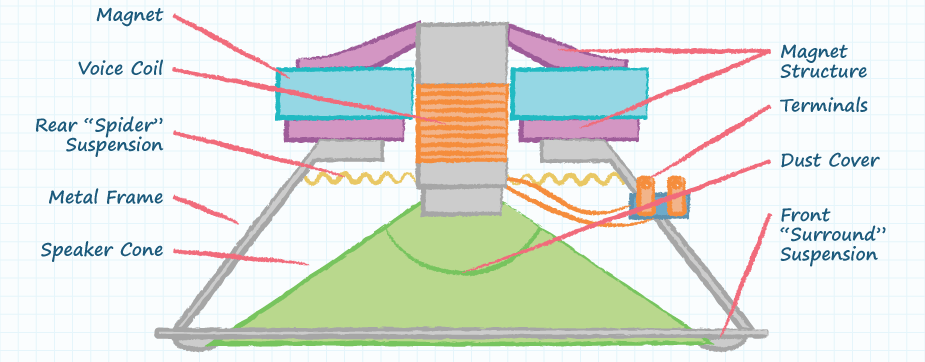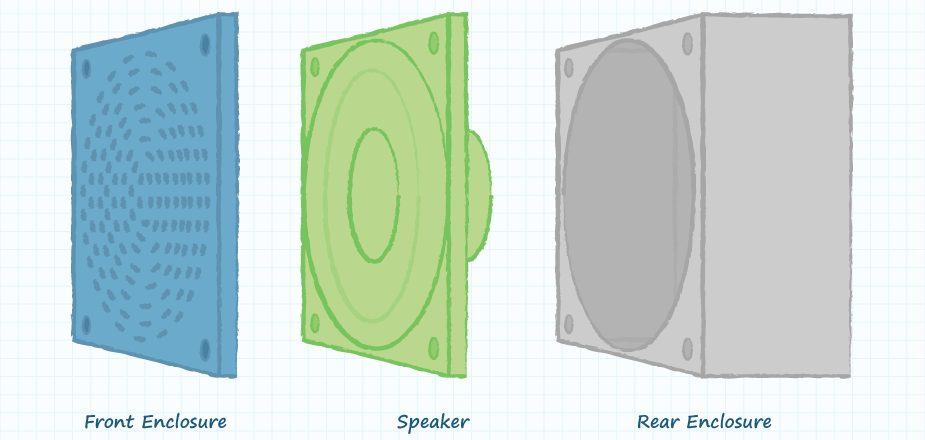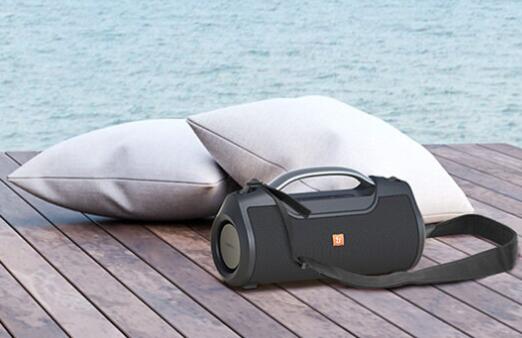Enclosures for mini and micro speakers are similar in purpose to those for larger speakers; to protect the speaker and to enhance the audio volume. Enclosures designed with a few simple guidelines will meet the needs of most applications.
A speaker consists of a diaphragm suspended in a rigid frame such that the diaphragm can freely move forward and backward. A coil of wire is attached to the diaphragm and suspended between the poles of a permanent magnet. Applying an electrical signal to this coil of wire causes it to move in the magnetic field. The diaphragm moves due to the movement of the coil and thus air pressure waves are created which are detected as sound. These air pressure waves radiate similarly well from both the front and the rear of the speaker. Unfortunately, the front and rear pressure waves are out of phase and thus can partially or completely cancel each other out and reduce the sound level.

Example diagram of a speaker
The front cavity of the enclosure serves to provide physical protection for the speaker, but should also be designed to minimize the attenuation of the desired sound.
Some common methods for creating the front cavity of a speaker enclosure are to use a screen or to create round or slotted holes in a solid plate. A hole pattern removing as little as 20% of the front plate can provide a reasonable compromise between protecting the speaker and minimizing the sound attenuation, while creating an array of holes approximately the size of the speaker helps to allow efficient sound propagation. The front of the enclosure should be spaced far enough from the speaker, so the moving diaphragm is not able to come in contact with the enclosure. In general, a spacing of 1 to 2 mm will be sufficient for most mini and micro speakers.
The rear of the speaker enclosure is typically designed to prevent radiation of the rear sound pressure wave. While it is possible to design the rear enclosure to utilize the rear pressure wave in order to enhance the frontal sound from the speaker, the complexity of such a design is beyond the scope of this blog.

Example drawing of a front and rear speaker enclosure
An effective design for the rear enclosure is an air-tight cavity. The interior of the cavity should be filled with sound absorbing material or the walls of the cavity should be rigid enough so as to not radiate sound.
The volume of the rear cavity is a compromise between speaker efficiency and size, with smaller sizes generally being more desirable in applications using mini or micro speakers. Unfortunately, a small rear cavity volume will create large changes in the air pressure in the rear enclosure due to the movement of the speaker diaphragm. These changes in the air pressure will inhibit the movement of the speaker diaphragm and thus limit the volume of sound produced from the front of the speaker. A balance between compact size and minimum pressure changes is desired when designing the rear enclosure volume. Constructing a rear cavity depth approximately equal to the speaker diameter is a good starting point for mini and micro speaker applications. At the same time, increasing the projected area of the rear cavity will allow for a reduction of the cavity’s depth, while maintaining the volume of the cavity.

A tight fitting junction between the front and rear of the speaker enclosure will help to reduce the sound propagation from the rear cavity to the front of the speaker. The speaker should be securely mounted at the interface between the front and rear cavities as the speaker will serve as a part of the rear enclosure structure. The secure mounting of the speaker will also ensure rattling sounds are not created by the speaker and enclosure. High density foam is often used when mounting speaker frames to enclosures to assist in creating a secure and tight fitting configuration.
The design of speaker enclosures is a balance between conflicting parameters, but acceptable compromises can be achieved with a minimum amount of effort. By adhering to these simple guidelines excellent sound quality can be achieved from mini and micro speakers without the need of an audio expert. Trendwoo also offers a range of enclosed speakers that have been optimized for superior sound quality and simplified design integration, giving engineers another sound output option without the need to design their own enclosure.
Copyright:@2020-2021
Comments Please sign in or sign up to post.
0
0 of 500 characters used